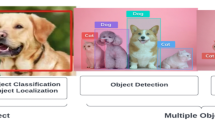Abstract
A neural learning-based crowd estimation system for surveillance in complex scenes at the platform of underground stations is presented. Estimation is carried out by extracting a set of significant features from the sequences of images. Feature indices are modeled by the neural networks to estimate the crowd density. The learning phase is based on our proposed hybrid algorithms which are capable of providing the global search characteristic and fast convergence speed. Promising experimental results were obtained in terms of estimation accuracy and real-time response capability to alert the operators automatically.
Similar content being viewed by others

References
Jukkala, P., Ylinan, J. and Raisanen, A.: Use of a millimetre wave radiometer for detecting pedestrian and bicycle traffic, Proc. 17th European Microwave Conference, Rome, Italy, Sept. 1987, pp. 585–589.
Mudally, S. S.: Novel computer-based infrared pedestrian data-acquistion system, Electronic Letters 15(13) (1979), 371–371.
Davies, A. C., Yin, J. H. and Velastin, S. A.: Crowd monitoring using image processing, Electronics & Communication Engineering Journal (1995), 37–47.
Regazzoni, C. S., Tesei, A. and Murino, V.: A real-time vision system for crowding monitoring, Proc. of IECON'93 (1993), 1860–1864.
Regazzoni, C. S. and Tesei, A.: Distributed data fusion for real-time crowding estimation, Signal Processing 53 (1996), 47–63.
Cravino, F., Dellucca, M. and Tesei, A.: DEKF system for crowding estimation by a multiplemodel approach, Electronics Letter 30(5) (1994), 390–391.
Gori, M. and Tesi, A.: Some examples of local minima during learning with back-propagation, parallel architectures and neural networks, Vietri sul Mare(IT), pp. 87–94, May 1990.
Gori, M. and Tesi, A.: On the problem of local minima in backpropagation, IEEE Trans. on Pattern Analysis and Machine Intell. 14(1) (1992), 76–86.
Cho, S. Y. and Chow, T.W. S.: A layer-by-layer least squares based recurrent networks training algorithm: stalling and escape, Neural Processing Letters 7(1) (1998).
Torn, A. and Zillinskas, A.: Global Optimization, Springer-Verlag, 1987.
Horst, R. and Pardalos, P. M.: Handbooks of Global Optimization, Kluwer Academic Publishers, The Netherlands, 1995.
Goffe, W. L., Ferrier, G. D. and Rogers, J.: Global optimization of statistical functions with simulated annealing, Journal of Econometrics 60 (1994), 65–99.
Leung, C. T. and Chow, T.W. S. A hybrid global learning algorithm based on global search and least squares techniques for backpropagation networks, Proc. of ICNN'97 of IEEE 3 (1997), 1890–1893.
Author information
Authors and Affiliations
Rights and permissions
About this article
Cite this article
Cho, SY., Chow, T.W.S. A Fast Neural Learning Vision System for Crowd Estimation at Underground Stations Platform. Neural Processing Letters 10, 111–120 (1999). https://doi.org/10.1023/A:1018781301409
Issue Date:
DOI: https://doi.org/10.1023/A:1018781301409



